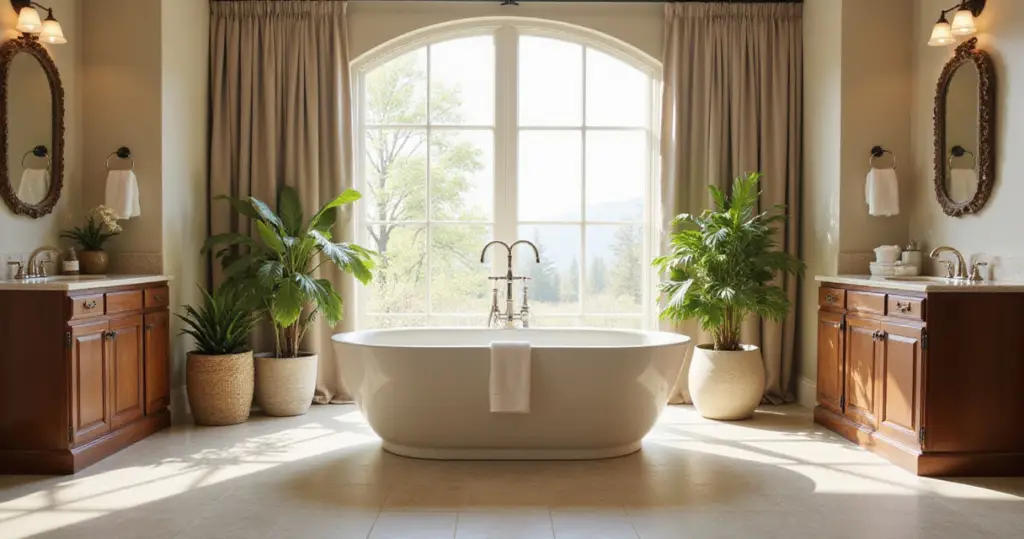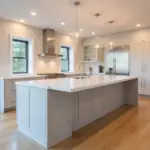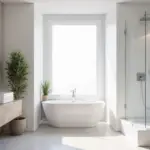The bathroom has evolved far beyond its utilitarian origins into a sanctuary of personal renewal and quiet luxury. In our increasingly connected world, this private retreat offers precious moments of solitude and restoration. The bathtub, once merely functional, now serves as the architectural heart of these intimate spaces—a sculptural element that defines both the room’s character and your daily ritual of self-care.
Selecting the perfect bathtub involves balancing aesthetic vision with practical needs, from space constraints to therapeutic benefits. The modern homeowner faces an inspiring array of possibilities: sleek contemporary designs that blur the line between art and function, traditional styles that anchor a room in timeless elegance, and innovative technologies that transform bathing into a multi-sensory wellness experience. Each choice carries the potential to fundamentally alter how you experience this most personal of spaces.
Whether you’re designing a new bathroom from the ground up or reimagining an existing space, these 24 carefully curated bathtub ideas will guide you through the landscape of possibilities. From space-saving solutions for compact urban dwellings to luxurious statement pieces that command attention, we’ll explore how the right bathtub can become both a functional necessity and a daily invitation to pause, breathe, and reconnect with yourself.
1. Choose a Freestanding Tub for Ultimate Design Flexibility
A freestanding bathtub commands attention like no other fixture, transforming an ordinary bathroom into a sophisticated retreat. Unlike built-in alternatives, these sculptural pieces offer complete design freedom—they can anchor the center of a room, nestle beside a window to capture natural light, or create an elegant focal point that draws the eye from the moment you enter. The visual impact extends beyond the tub itself, as the exposed floor beneath creates an illusion of expanded space while allowing for creative lighting scenarios that highlight the tub’s form.
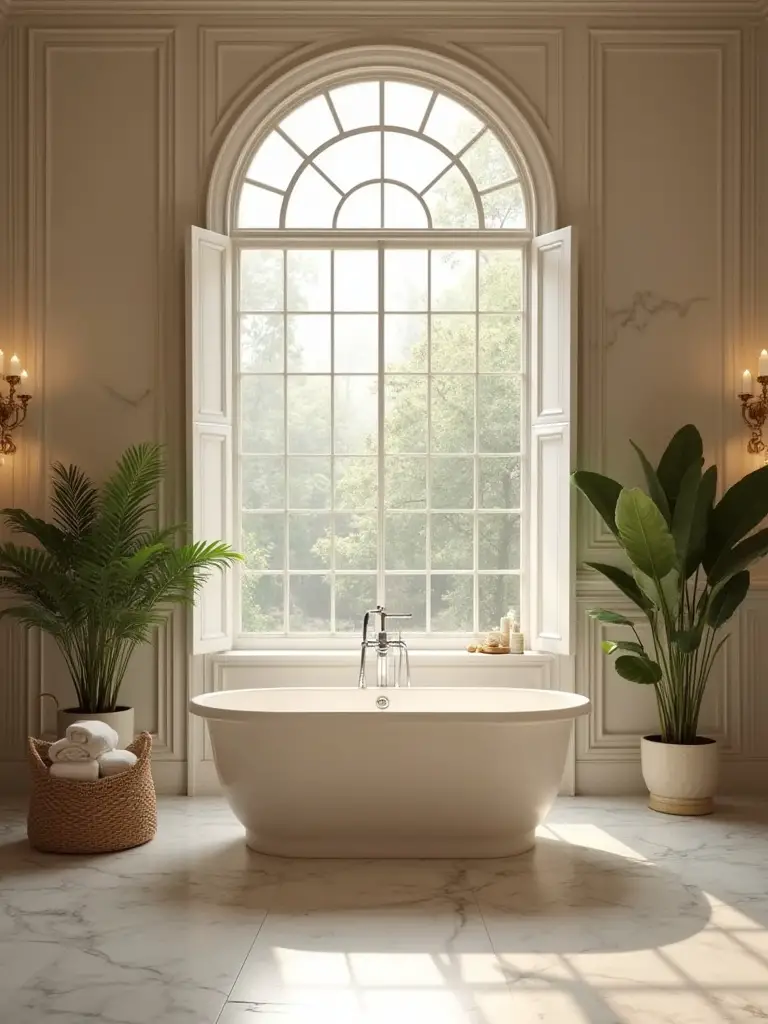
The practical benefits match the aesthetic appeal. Installation flexibility means you can position the tub to optimize traffic flow and take advantage of architectural features like windows or alcoves. Many freestanding models offer deeper soaking depths than their built-in counterparts, while the all-around access makes cleaning straightforward. The investment often pays dividends in home value, as these statement pieces consistently rank among the most desired features in luxury bathroom surveys.
Key considerations for freestanding tub installation:
- Structural assessment – Verify floor joists can support 800-1200 pounds when filled
- Plumbing access – Plan for floor-mounted or wall-mounted faucet configurations
- Spatial requirements – Allow minimum 6 inches clearance on all sides for cleaning
The craftsmanship behind these pieces tells its own story. We’ve been working behind the scenes with artisans who understand that a freestanding tub isn’t just functional—it’s furniture for the bathroom, requiring the same attention to proportion and finish as any heirloom piece.
2. Embrace Vintage Charm with an Elegant Clawfoot Bathtub
The clawfoot bathtub represents more than nostalgic appeal—it’s a masterclass in enduring design that has gracefully adapted to contemporary aesthetics. These elevated beauties create an airy feeling that built-in tubs simply cannot achieve, as the visible floor space beneath makes rooms appear larger while the decorative feet add architectural interest. The classic silhouette works equally well in a restored Victorian home or a modern farmhouse, proving that good design transcends trends.
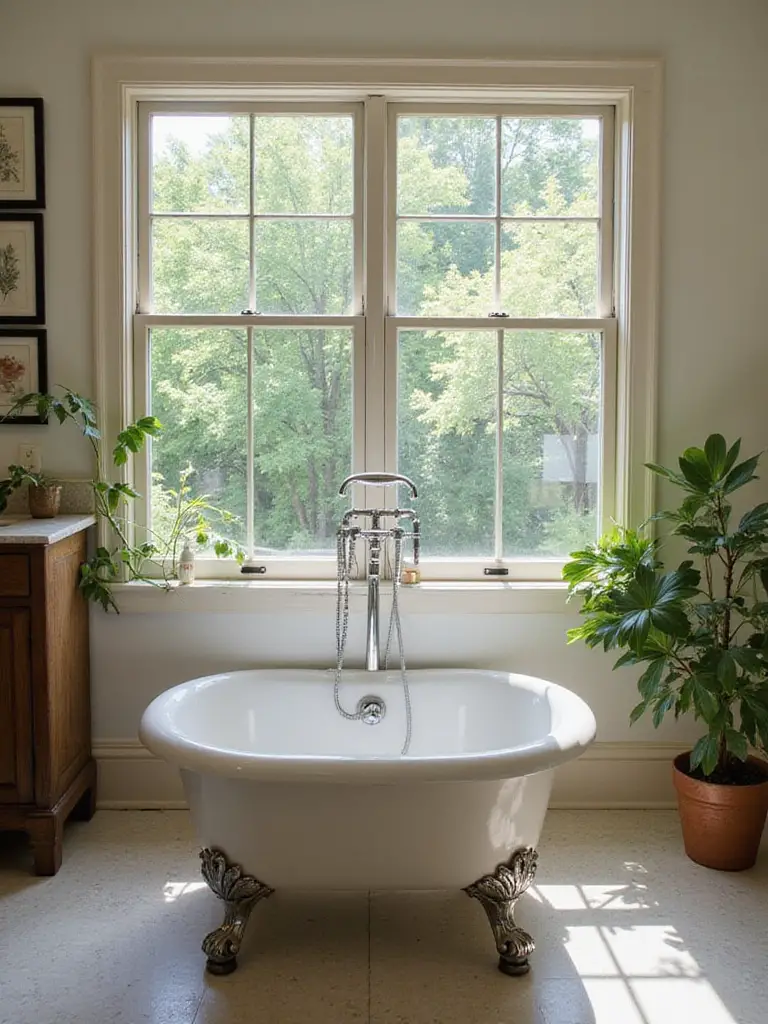
Beyond their visual impact, clawfoot tubs offer practical advantages that modern homeowners appreciate. The elevated design promotes better air circulation around the tub, reducing moisture buildup and potential mold issues. Cast iron versions provide exceptional heat retention, keeping water warm for extended soaks, while their freestanding nature allows for easy plumbing access during maintenance. The variety of foot styles—from ornate lion’s paws to sleek contemporary pedestals—means you can customize the look to match your aesthetic vision.
Popular clawfoot tub configurations:
- Single slipper – High back on one end for comfortable reclining
- Double slipper – Raised ends on both sides for two-person soaking
- Roll rim – Classic flat rim design with timeless appeal
The interplay between the colors creates something unexpected in these pieces. Unlike mass-produced alternatives, the hand-cast nature of quality clawfoot tubs means subtle variations in the finish that mark each piece as unique, developing character over decades of use.
3. Maximize Space Efficiency with a Practical Alcove Bathtub
Alcove bathtubs represent the art of doing more with less, transforming the constraint of limited space into an opportunity for streamlined elegance. By utilizing three existing walls, these built-in solutions free up valuable floor space while creating a clean, integrated look that makes small bathrooms feel more spacious. The enclosed nature also provides better water containment and creates a more intimate bathing environment that many find preferable to exposed installations.
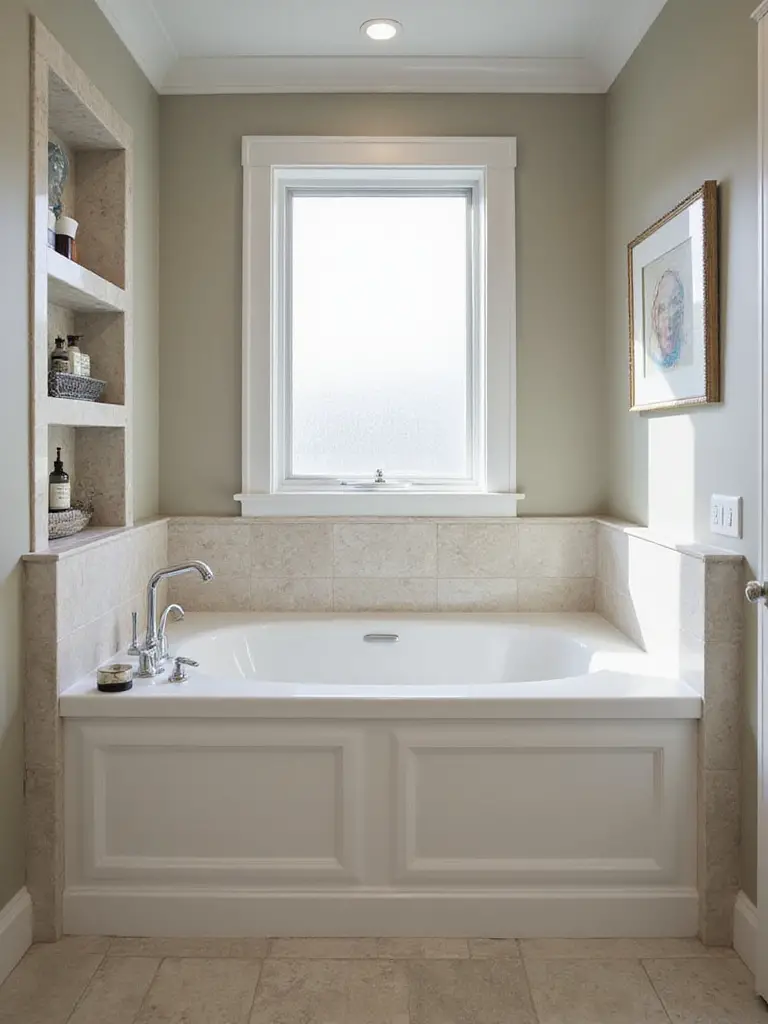
The economic advantages extend beyond the initial purchase price. Installation costs typically run 30-40% lower than freestanding alternatives due to simplified plumbing and fewer finished surfaces required. Maintenance becomes more manageable with fewer exposed areas to clean, while the integrated design allows for seamless shower combinations that maximize functionality. Modern alcove tubs have evolved far beyond basic rectangles, with curved backs, armrests, and integrated lumbar support that rival luxury freestanding models.
Alcove tub optimization strategies:
- Recessed storage – Built-in niches eliminate clutter without sacrificing space
- Integrated seating – Corner seats or built-in ledges enhance comfort
- Overflow placement – Front-positioned overflows maximize soaking depth
What makes this design special is the way it disappears into the architecture while providing full functionality. The visual weight balances perfectly when you surround these installations with materials that extend up the walls, creating a cohesive wet room aesthetic that feels intentional rather than compromised.
4. Achieve Seamless Integration with a Drop-in Bathtub Design
Drop-in bathtubs offer the ultimate in customization, allowing you to create a completely bespoke installation that appears built specifically for your space. The rim-mounted design enables you to wrap the tub in any material that suits your aesthetic—from book-matched marble slabs to warm wood decking or contemporary concrete. This flexibility means the tub becomes part of a larger design narrative rather than a separate element competing for attention.
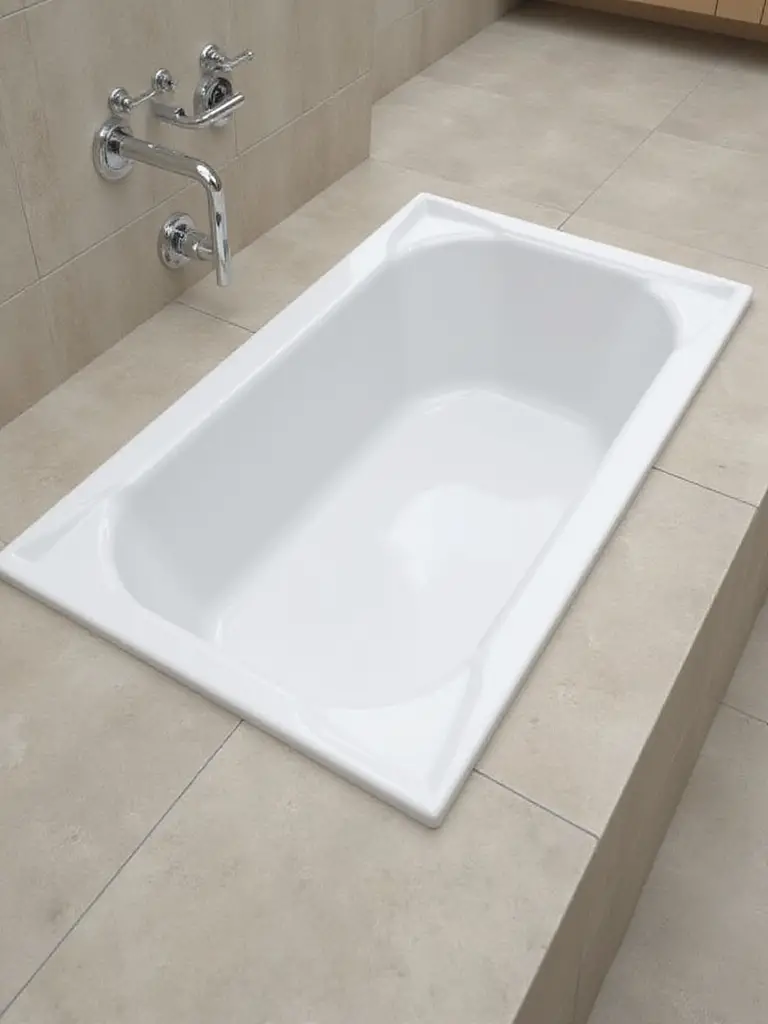
The structural advantages of drop-in installation create long-term benefits that justify the initial investment. The tub sits fully supported within a custom frame, eliminating flex and movement that can cause problems with other installation methods. This stability extends the life of both the tub and surrounding finishes while providing opportunities for integrated features like built-in storage, towel warming, or even hidden speakers for a spa-like experience.
Professional installation requires careful attention to waterproofing and access panels, but the results justify the complexity. The seamless integration possible with drop-in tubs allows for design continuity that makes spaces feel larger and more cohesive. Whether you’re creating a minimalist wet room or an opulent master suite, the drop-in approach provides the foundation for truly custom results.
The composition comes together when you extend the same materials from the tub deck to other surfaces in the room, creating visual flow that makes the space feel intentionally designed rather than assembled from separate components.
5. Optimize Compact Layouts with a Space-Saving Corner Tub
Corner bathtubs transform awkward angles into functional assets, proving that thoughtful design can make every square inch count. These triangular or curved installations nestle into corners that might otherwise remain underutilized, freeing up central floor space for better traffic flow or additional fixtures. The angled placement creates interesting sight lines that can make rectangular rooms feel more dynamic while providing surprisingly generous soaking capacity within a compact footprint.
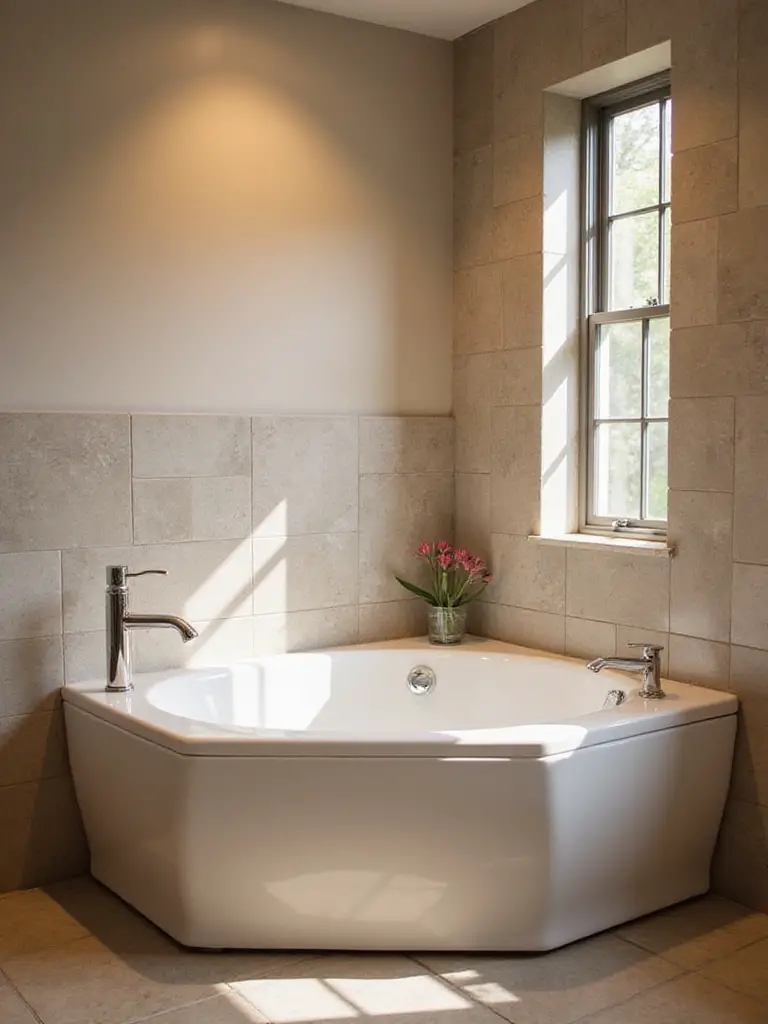
Modern corner tubs have evolved significantly from their 1980s predecessors, now offering sleek profiles and contemporary styling that complement today’s design sensibilities. Many feature offset designs that provide deeper soaking on one side while maintaining space efficiency, and integrated features like armrests and lumbar support enhance comfort. The corner placement also creates natural privacy, as the tub becomes nestled into the room’s architecture rather than exposed in the center.
Corner tub layout benefits:
- Traffic flow – Opens central pathways for easier movement
- Fixture placement – Creates space for larger vanities or storage
- Visual interest – Breaks up rectangular room monotony
The challenge of awkward spaces becomes easier when you view corners as opportunities rather than obstacles. The unexpected pairing that always works is combining a corner tub with a separate shower, giving you the best of both worlds without the compromises typical of combination units.
6. Experience Deep Relaxation in a Compact Japanese Soaking Tub
Japanese soaking tubs, or ofuro, represent a fundamentally different approach to bathing that prioritizes mindful relaxation over utilitarian function. These deep, compact vessels are designed for seated soaking in shoulder-deep water, creating an immersive experience that promotes meditation and stress relief. The upright posture encourages proper spinal alignment while the hydrostatic pressure provides gentle compression that can improve circulation and reduce muscle tension.

The space efficiency of Japanese-style tubs makes them ideal for urban environments where square footage comes at a premium. Despite their compact footprint—often 40% smaller than traditional Western tubs—they provide a more immersive bathing experience through their depth and design. The ritual aspect of ofuro bathing, which traditionally involves cleansing before soaking, transforms the daily routine into a mindful practice that many find therapeutic in our fast-paced world.
Traditional materials like hinoki cypress add aromatherapy benefits through natural wood oils, while modern interpretations in stone resin or copper provide easier maintenance without sacrificing the essential design principles. The key is understanding that these tubs serve a different purpose than conventional bathtubs—they’re designed for contemplation and restoration rather than quick ablutions.
As morning light filters through nearby windows, the compact nature of these installations allows for creative placement that maximizes natural light and views, turning the daily soak into a connection with the changing seasons and natural rhythms.
7. Enhance Safety and Independence with a Walk-in Bathtub
Walk-in bathtubs address the fundamental challenge of bathroom safety without compromising the therapeutic benefits of soaking. The low-threshold entry eliminates the dangerous step-over required by traditional tubs, reducing fall risk by up to 70% according to occupational therapy studies. Built-in seating and grab bars provide additional stability, while quick-drain systems minimize the time spent standing in the tub, addressing the primary safety concerns that prevent many from enjoying regular baths.
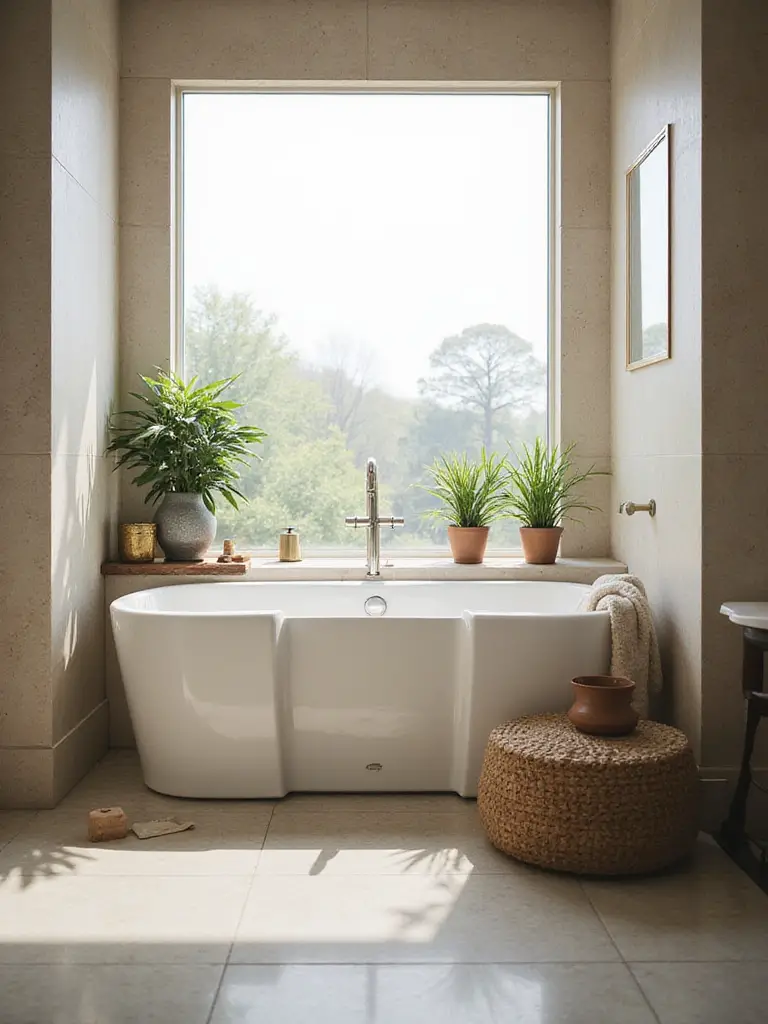
Modern walk-in tubs have evolved far beyond purely medical devices to become sophisticated wellness systems. Therapeutic features like hydrotherapy jets, aromatherapy dispensers, and chromotherapy lighting transform necessary safety modifications into luxury amenities. The heated seats available in premium models maintain comfort during filling and draining, while dual-drain systems can empty a full tub in under two minutes, reducing wait times significantly.
Essential walk-in tub features:
- Low-threshold door – Typically 3-7 inches high versus 14-16 inches for standard tubs
- Built-in seating – Contoured seats with back support for comfort
- Safety systems – Anti-slip surfaces, grab bars, and emergency drain options
The environmental story behind quality walk-in tubs includes consideration of aging-in-place principles that allow homeowners to remain in their homes longer, reducing the environmental impact of relocating to assisted living facilities while maintaining independence and dignity.
8. Target Muscle Relief with a Therapeutic Jetted Bathtub System
Jetted bathtub systems transform passive soaking into active hydrotherapy, using strategically placed water jets to provide targeted massage that can address specific areas of tension and discomfort. The pulsating action increases blood flow to treated areas, potentially reducing inflammation and accelerating recovery from physical exertion. For individuals dealing with chronic pain conditions like arthritis or fibromyalgia, regular hydrotherapy sessions can provide significant relief without pharmaceutical intervention.
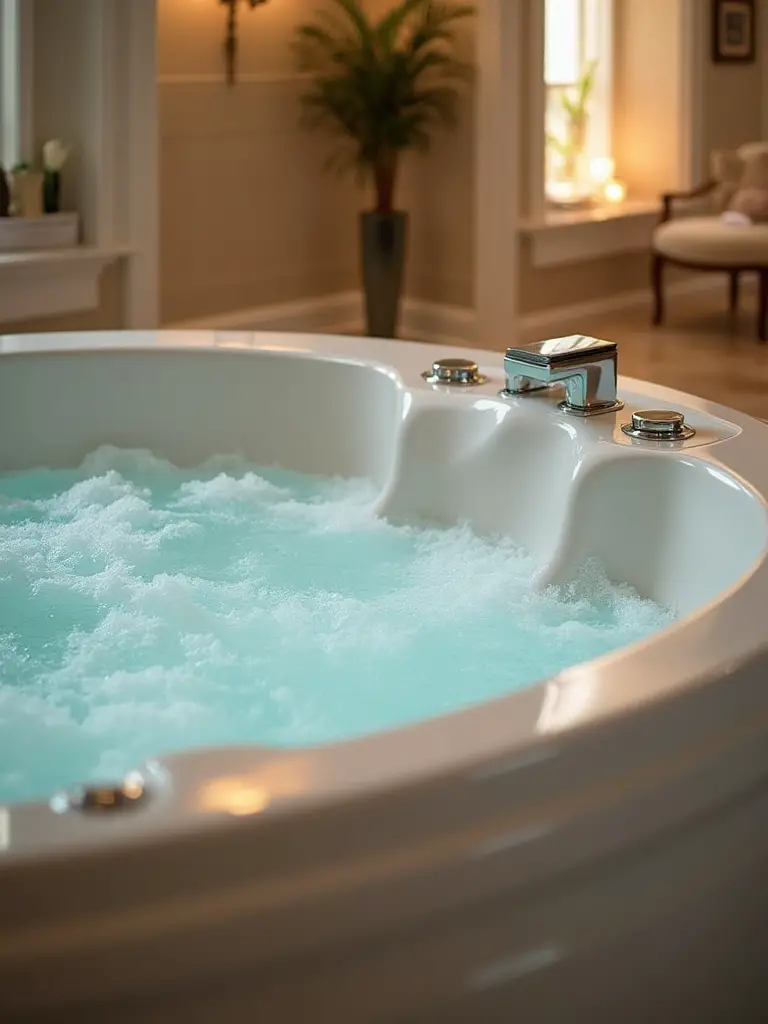
The technology behind modern jetted systems has advanced considerably, with variable-speed pumps allowing precise control over pressure and flow patterns. Some systems offer alternating jet sequences that prevent habituation, while others provide focused streams for trigger point therapy. The combination of warm water immersion and mechanical massage creates a synergistic effect that enhances the benefits of each therapy individually.
Installation requires careful planning for electrical and plumbing requirements, as these systems typically need dedicated 20-amp circuits and robust drain capacity. Proper maintenance involves regular cleaning of the jet system to prevent biofilm buildup, but modern designs with self-cleaning cycles and antimicrobial surfaces make this less burdensome than earlier generations.
The maker’s journey from basic whirlpool systems to today’s sophisticated hydrotherapy platforms reflects growing understanding of water’s therapeutic properties and the engineering required to harness them effectively in a home environment.
9. Enjoy Gentle Full-Body Massage from an Air Bathtub System
Air bathtubs create a uniquely soothing experience through thousands of tiny bubbles that provide gentle, full-body stimulation without the intensity of traditional water jets. The effervescent action promotes lymphatic drainage and superficial circulation while creating a champagne-like sensation that many find more relaxing than aggressive water massage. The air-only system eliminates concerns about water recirculation and bacterial growth, making maintenance simpler and more hygienic.

The therapeutic benefits extend beyond simple relaxation, as the micro-massage action can help reduce fluid retention and promote skin health through gentle exfoliation and increased circulation. The enveloping nature of the bubble massage provides stress relief through sensory stimulation that triggers the body’s relaxation response. Many users report improved sleep quality after evening sessions, as the gentle stimulation helps transition the nervous system into a rest state.
Air tub system advantages:
- Hygienic operation – Uses fresh air rather than recirculated water
- Gentle therapy – Suitable for sensitive skin and circulation issues
- Easy maintenance – Self-draining air lines prevent bacterial buildup
The tactile experience changes the entire room’s energy when you add the subtle sound of bubbling water and the visual effect of thousands of tiny bubbles creating movement and light refraction throughout the bath, transforming a simple soak into a multi-sensory experience.
10. Invest in Longevity with a Classic Cast Iron Bathtub
Cast iron bathtubs represent the pinnacle of durability and thermal performance, offering heat retention that can extend comfortable soaking time by 45-60 minutes compared to lighter materials. The dense material absorbs heat slowly but releases it gradually, maintaining water temperature through the thermal mass principle. This efficiency can reduce hot water consumption during long soaks while providing consistently comfortable bathing conditions.
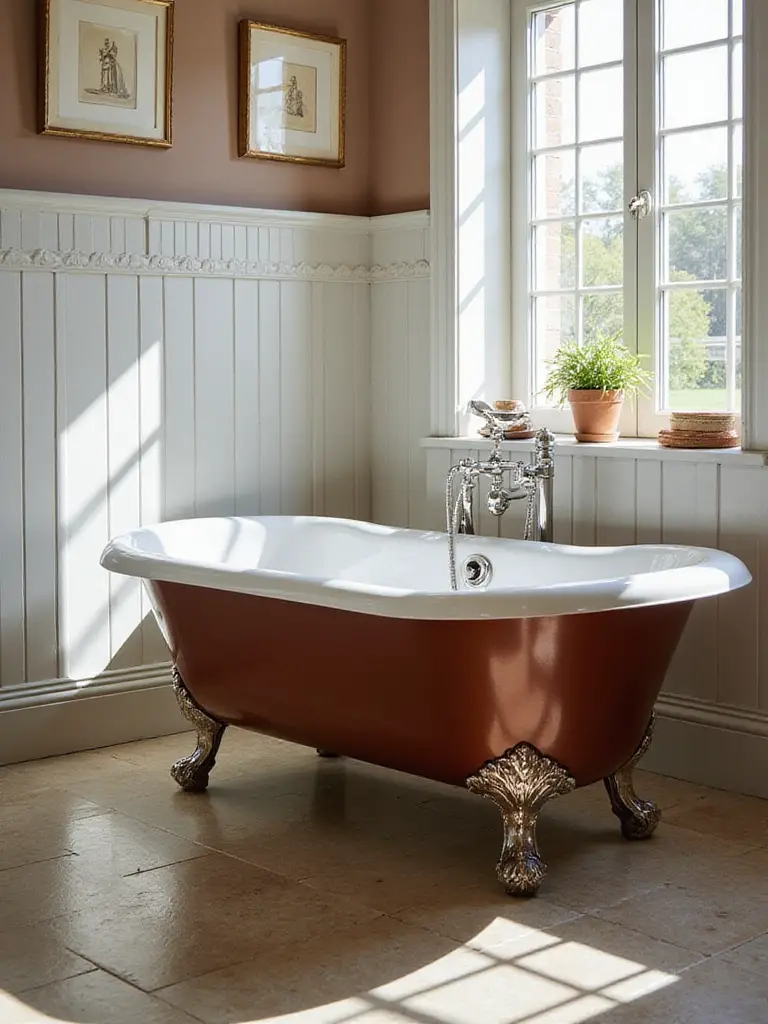
The longevity of cast iron installations often spans multiple generations, with many antique examples still providing excellent service after a century of use. The porcelain enamel finish, when properly maintained, resists staining, chipping, and bacterial growth while maintaining its lustrous appearance. Modern manufacturing techniques have improved both the base iron composition and enamel application, resulting in products that exceed the already impressive durability of vintage examples.
The substantial weight of cast iron—typically 300-500 pounds empty—requires structural assessment and often reinforcement of floor joists. However, this mass contributes to the stability and solid feel that users consistently prefer over lighter alternatives. The investment in proper installation pays dividends in decades of reliable service and the satisfaction of owning a truly substantial fixture.
The craftsmanship in premium cast iron tubs tells a story of traditional manufacturing methods adapted to modern quality standards, where each piece undergoes multiple firing processes to achieve the perfect balance of durability and beauty.
11. Balance Cost and Quality with a Versatile Acrylic Bathtub
Acrylic bathtubs offer an ideal entry point into quality bathing fixtures, providing excellent value through their combination of affordability, design flexibility, and practical performance. The thermoformed construction allows for complex curves and ergonomic features that would be prohibitively expensive in other materials, while the non-porous surface resists staining and bacterial growth. Weight advantages make installation simpler and less expensive, often eliminating the need for structural reinforcement.
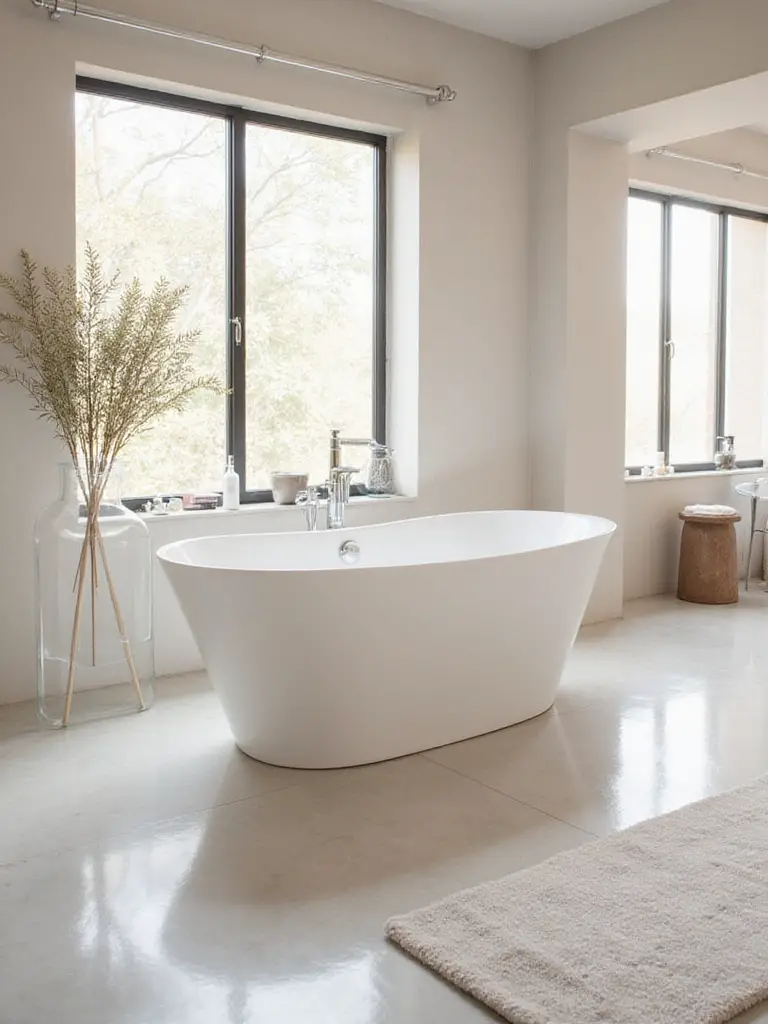
Modern acrylic formulations have addressed earlier concerns about durability and appearance retention. High-quality acrylic maintains its color and gloss for decades, while improved thickness and reinforcement techniques prevent the flexing that plagued earlier models. The material naturally feels warm to the touch and provides adequate heat retention for comfortable soaking, though not matching the thermal mass of cast iron or stone.
Acrylic tub selection criteria:
- Thickness – Minimum 4-5mm for stability and longevity
- Reinforcement – Fiberglass backing and resin coating for structural integrity
- Warranty – 10+ year coverage indicating manufacturer confidence
The versatility reveals itself when you consider the range of available configurations, from basic alcove models to sophisticated freestanding designs with integrated features like chromotherapy lighting and built-in speakers, all at price points that make luxury accessible.
12. Create Sculptural Impact with a Stone Resin Bathtub
Stone resin bathtubs bridge the gap between natural stone luxury and practical functionality, offering the visual weight and thermal properties of stone with improved workability and reduced maintenance requirements. The composite material typically combines natural minerals with polymer binders, creating a surface that feels substantial and luxurious while remaining non-porous and stain-resistant. The matte finish options provide a contemporary aesthetic that complements modern architectural trends.
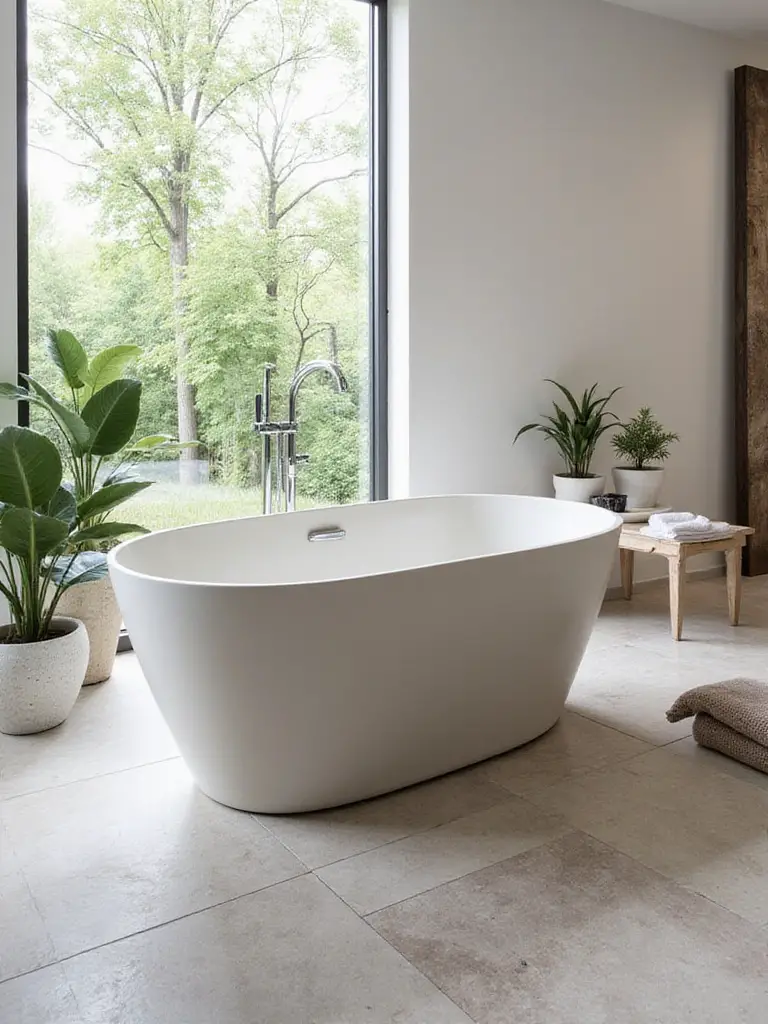
The manufacturing process allows for seamless construction and precise edge details that would be difficult to achieve with natural stone, while the material’s workability enables repairs and modifications that solid stone cannot accommodate. Heat retention approaches that of cast iron, while the surface remains comfortable to touch even in cold environments. The weight, while substantial, typically falls between acrylic and cast iron, simplifying installation requirements.
Design possibilities expand significantly with stone resin, as the material can be molded into complex shapes and integrated with features like overflow channels and drain covers that appear seamlessly incorporated rather than added. Color options range from classic whites and grays to bold contemporary hues, with some manufacturers offering custom color matching for specific design requirements.
The environmental journey of quality stone resin includes consideration of mineral sourcing and manufacturing processes that minimize waste while creating products designed for decades of service, representing a more sustainable approach than frequent replacement of lesser materials.
13. Add Character with a Distinctive Copper Bathtub
Copper bathtubs bring warmth and character that deepens with age, as the living finish develops a unique patina that tells the story of its use. The antimicrobial properties of copper create a naturally hygienic bathing environment, with EPA-registered antimicrobial effects that eliminate bacteria within hours of contact. The thermal conductivity of copper provides excellent heat retention while the metal’s responsiveness to temperature changes creates a bathing experience that feels alive and reactive.
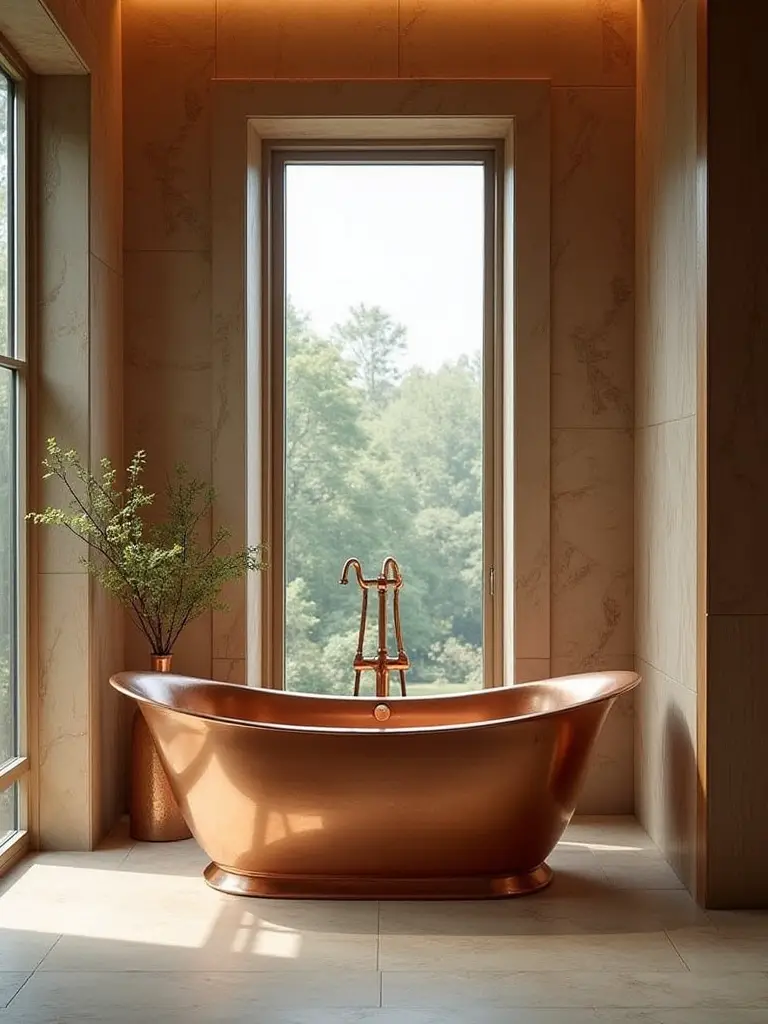
The craftsmanship required for copper tub construction involves traditional metalworking techniques adapted to modern precision, with hand-hammered finishes adding texture and visual interest that machine production cannot replicate. The material’s malleability allows for complex curves and integrated features, while its durability ensures that proper care will result in generations of service. The patina development can be controlled through various treatments, from maintaining bright copper to encouraging specific patina colors.
Copper tub maintenance essentials:
- Protective waxing – Regular application preserves desired finish
- pH-neutral cleaners – Avoid acidic or abrasive products
- Patina management – Embrace natural aging or maintain specific appearance
The unexpected environmental benefit comes from copper’s complete recyclability and the longevity that reduces replacement frequency, while the antimicrobial properties may reduce the need for chemical sanitizers in maintenance routines.
14. Connect with Nature through a Wooden Bathtub Experience
Wooden bathtubs offer a sensory experience that synthetic materials cannot replicate, engaging multiple senses through natural aromatics, thermal properties, and tactile qualities that create a spa-like atmosphere. Traditional woods like hinoki cypress or cedar provide natural aromatherapy benefits, while the thermal properties create a bathing experience that feels warmer and more comfortable than metal or stone alternatives. The organic aesthetic brings biophilic design principles into the bathroom, creating a connection to nature within the built environment.
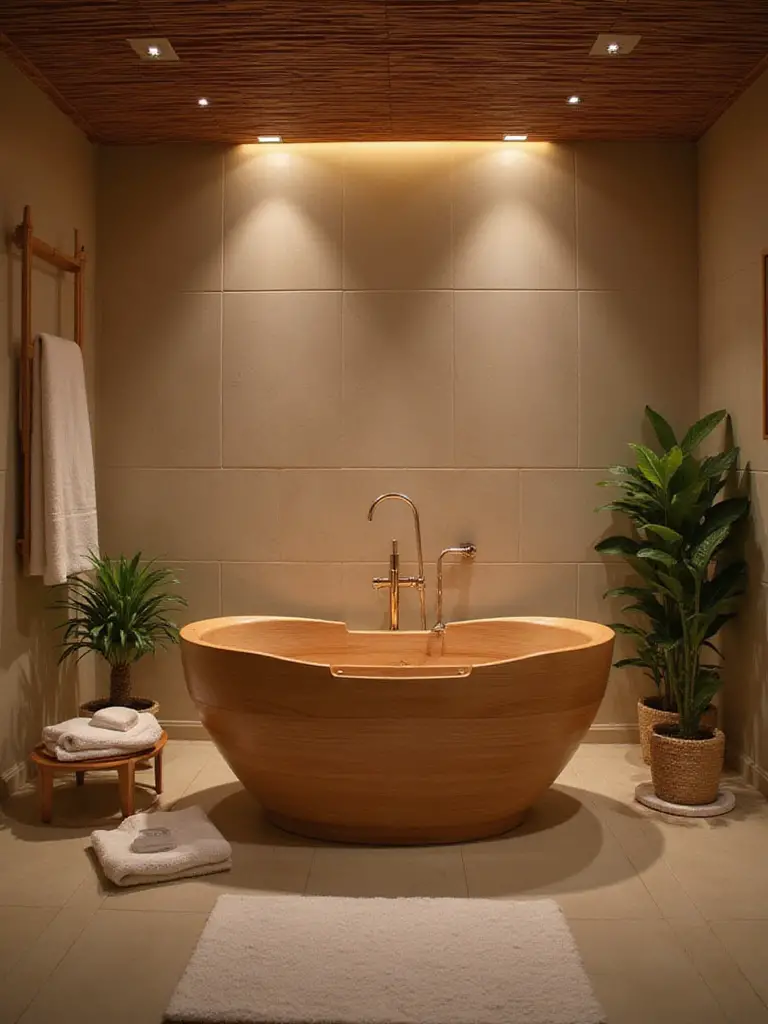
The construction of quality wooden tubs requires specialized joinery techniques and careful wood selection to ensure water resistance and dimensional stability. Properly constructed wooden tubs can provide decades of service with appropriate maintenance, developing character and patina that enhances their appeal over time. The insulation properties of wood extend comfortable soaking time while the natural flexibility provides a more forgiving surface than rigid materials.
Modern wooden tub designs incorporate traditional Japanese soaking principles with contemporary ergonomics, creating vessels that promote relaxation and mindfulness. The ritual of caring for a wooden tub—including regular oiling and humidity management—becomes part of the ownership experience, connecting users to traditional craftsmanship and natural materials in ways that manufactured products cannot achieve.
The cultural heritage preserved in wooden tub construction includes centuries of knowledge about wood selection, joinery techniques, and finishing methods that create functional art pieces capable of transforming daily bathing into a meditative practice.
15. Achieve Budget-Friendly Installation with Fiberglass Bathtubs
Fiberglass bathtubs provide the most accessible entry into bathtub replacement or installation, offering significant cost savings without sacrificing basic functionality or aesthetic appeal. The lightweight construction—typically 60-100 pounds—eliminates structural concerns and reduces installation labor, while the molded-in features like soap dishes and grab bars add convenience without additional cost. The gel-coat finish provides adequate durability for most residential applications while maintaining an attractive appearance with proper care.
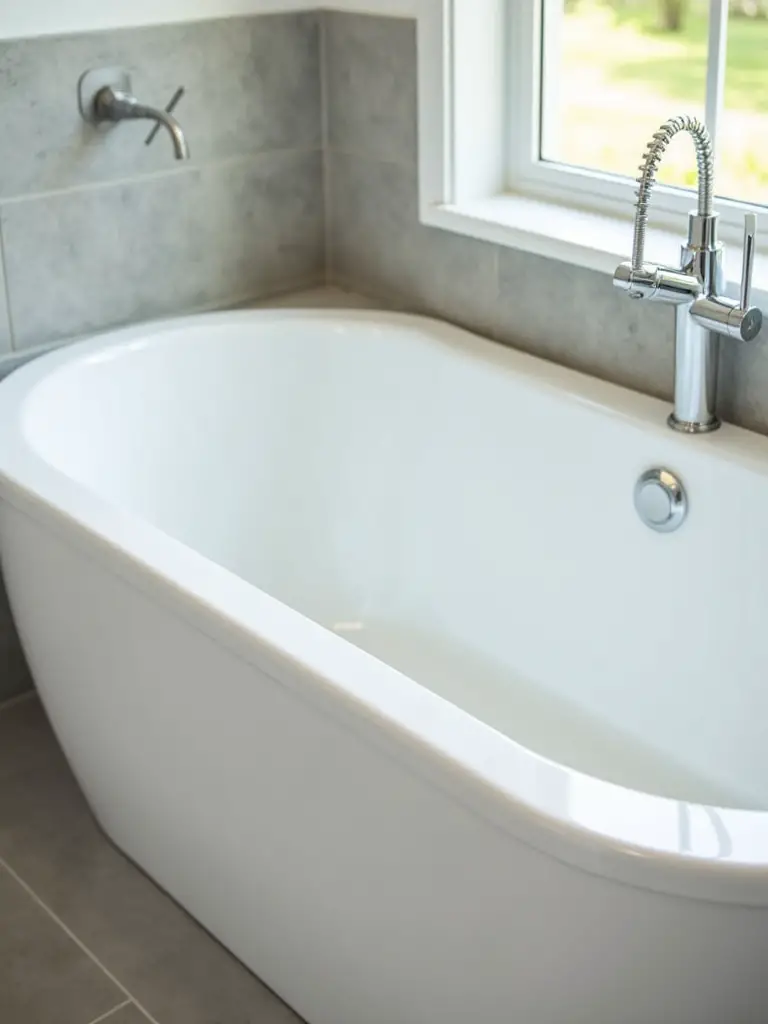
The installation advantages of fiberglass extend beyond weight considerations to include simplified plumbing connections and reduced preparation requirements. The flexibility of the material allows for minor adjustments during installation, accommodating slight variations in framing or plumbing rough-in that might require expensive modifications with rigid materials. The integrated flange system simplifies waterproofing and wall attachment, reducing installation time and complexity.
Fiberglass tub installation tips:
- Mortar bed support – Provides stability and prevents flexing
- Proper ventilation – Prevents moisture buildup and extends life
- Quality fasteners – Stainless steel screws prevent corrosion
While fiberglass may not offer the longevity or luxury feel of premium materials, it provides reliable service for budget-conscious projects and temporary installations, proving that functional bathing solutions don’t require significant investment when priorities focus on basic needs rather than luxury features.
16. Refresh Existing Fixtures with Custom Bathtub Liners
Bathtub liners offer a middle ground between complete replacement and surface refinishing, providing a new bathing surface without the disruption and expense of full renovation. The precision-molded acrylic shell fits over existing tubs, creating a seamless new surface that addresses issues like staining, minor damage, and outdated colors. Installation typically requires only one day, minimizing household disruption while delivering results that can last 10-15 years with proper care.

The engineering behind quality liners involves precise measurement and custom manufacturing that ensures perfect fit and proper drainage. The non-porous acrylic surface resists staining and bacterial growth while providing a warmer feel than porcelain or fiberglass. The installation process includes thorough cleaning and preparation of the existing surface, followed by secure bonding that creates a permanent installation indistinguishable from a new tub.
Cost comparisons typically show liner installation at 50-70% of replacement costs, while the time savings and reduced disruption add value beyond simple dollar calculations. The warranty coverage available with professional installation provides peace of mind, while the improved appearance and functionality can significantly enhance bathroom aesthetics and user satisfaction.
The sustainable journey of liner installation includes extending the useful life of existing fixtures while avoiding the environmental impact of demolition and disposal, representing a more environmentally conscious approach to bathroom updates.
17. Restore Original Beauty through Professional Bathtub Resurfacing
Professional bathtub resurfacing transforms worn, stained, or outdated tubs into like-new fixtures through advanced coating systems that provide durability and appearance comparable to new installations. The multi-step process includes thorough cleaning, surface preparation, primer application, and multiple finish coats that create a smooth, glossy surface resistant to staining and wear. Quality resurfacing can extend tub life by 10-15 years while addressing aesthetic concerns at a fraction of replacement cost.
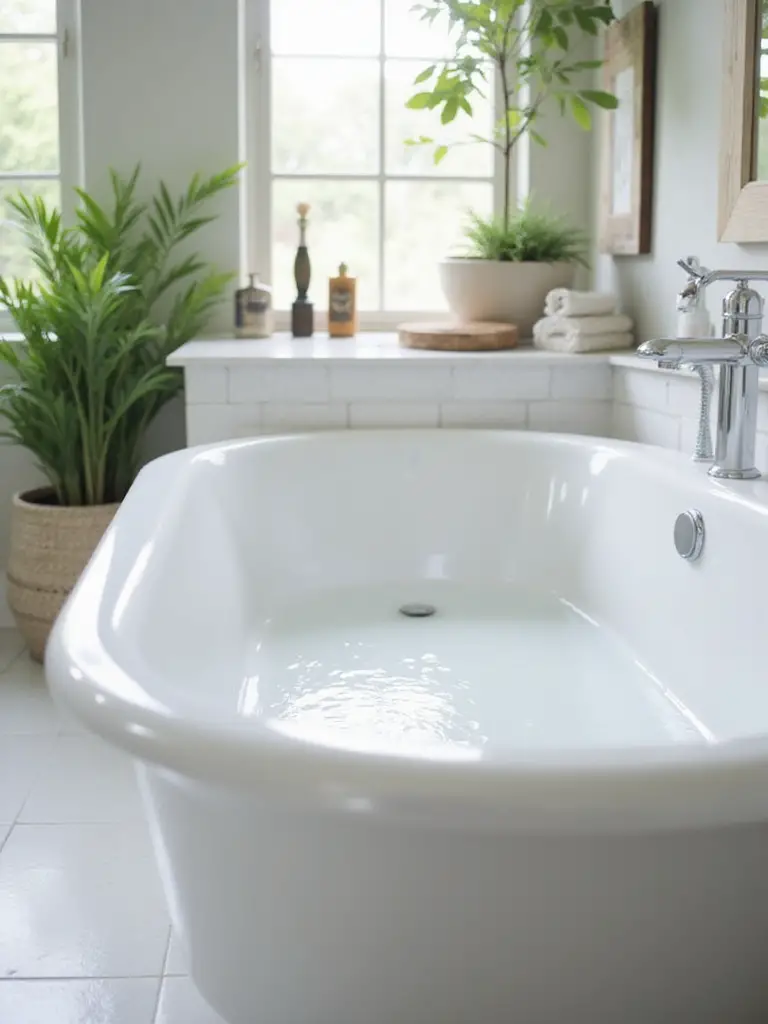
The chemistry behind modern resurfacing materials has evolved significantly, with two-part epoxy and urethane systems providing superior adhesion and durability compared to earlier single-component coatings. Professional application includes temperature and humidity control that ensures proper curing, while surface preparation techniques remove all traces of soap scum, mineral deposits, and previous coatings that could compromise adhesion.
Resurfacing success factors:
- Surface preparation – Complete removal of all residues and contaminants
- Environmental control – Proper temperature and ventilation during application
- Curing time – Full 48-72 hours before use ensures maximum durability
The transformation reveals itself not just in appearance but in functionality, as the new surface provides improved slip resistance and easier cleaning compared to worn original finishes, while color options allow updating outdated fixtures to match contemporary design preferences.
18. Enhance Wellness with Chromotherapy Bathtub Lighting
Chromotherapy bathtubs integrate color therapy principles into the bathing experience, using LED lighting systems to create mood-enhancing environments that can influence relaxation, energy levels, and overall well-being. The underwater lighting creates an immersive experience where colored light interacts with moving water to produce calming or energizing effects depending on the selected spectrum. Research suggests that specific colors can influence circadian rhythms and stress hormone production, making chromotherapy a practical wellness tool.
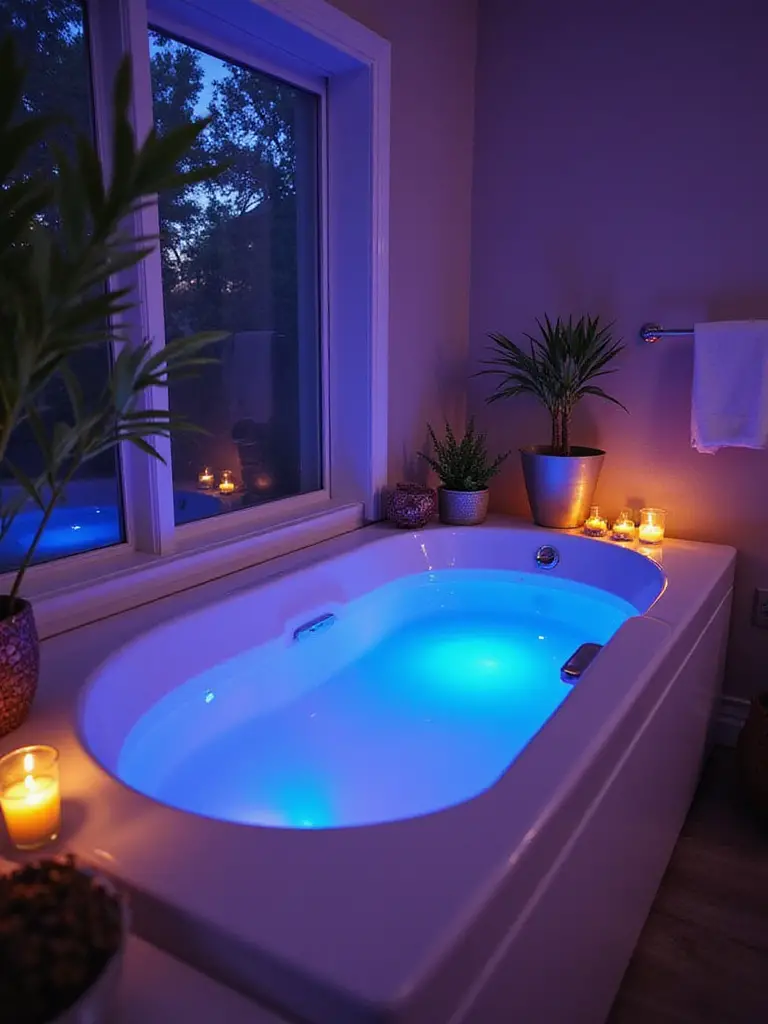
The technology behind quality chromotherapy systems includes waterproof LED arrays with full spectrum capability and programmable controllers that allow precise color selection and timing sequences. Some systems integrate with smart home platforms, enabling voice control and automated routines that coordinate lighting with other bathroom systems. The energy efficiency of LED technology makes continuous operation practical while the long lifespan reduces maintenance requirements.
Chromotherapy color applications:
- Blue spectrum – Promotes relaxation and stress reduction
- Green tones – Balancing and harmonizing effects
- Warm colors – Energizing and mood-lifting properties
The mood shifts dramatically when you add coordinated aromatherapy and sound systems, creating a multi-sensory environment that transforms routine bathing into a therapeutic ritual that addresses both physical and psychological well-being.
19. Maintain Comfort with Heated Surface Bathtub Technology
Heated surface bathtubs eliminate the shock of cold porcelain while extending comfortable soaking time through gentle warming elements integrated into the tub’s structure. The technology maintains surface temperatures at comfortable levels while preventing rapid heat loss from bath water, potentially extending enjoyable soaking time by 30-45 minutes. The consistent warmth enhances muscle relaxation and therapeutic benefits while reducing the need for hot water additions during extended sessions.
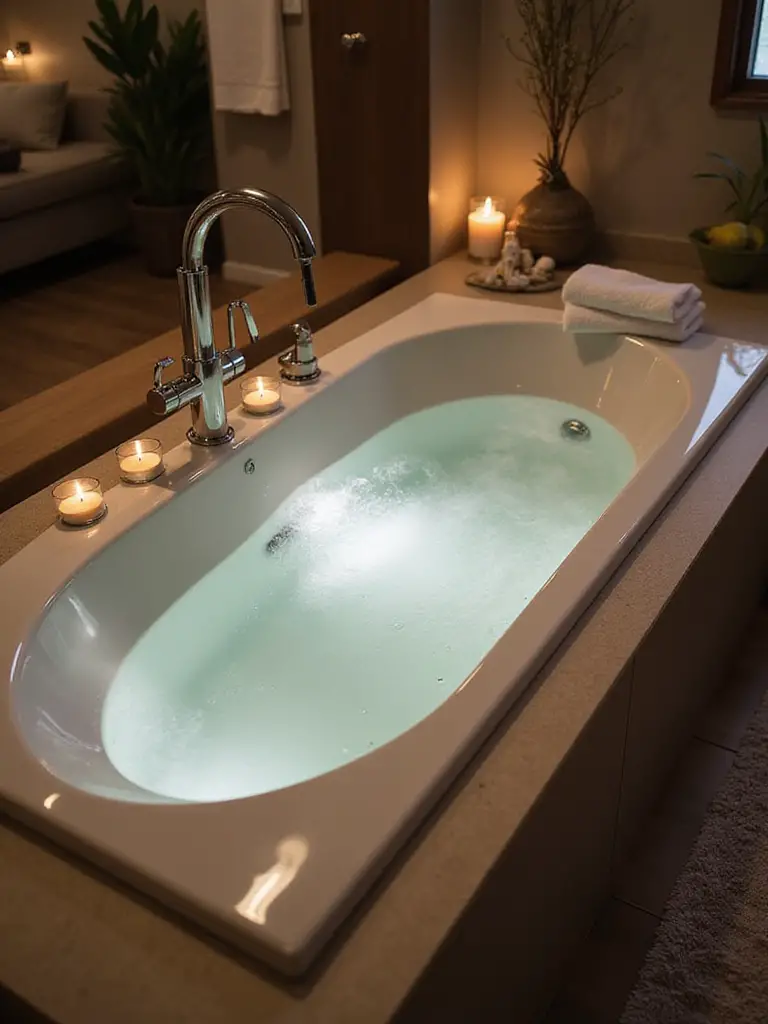
The engineering behind heated surfaces involves low-voltage heating elements embedded within the tub material, controlled by precision thermostats that maintain safe, comfortable temperatures. Safety systems include ground fault protection and temperature limiting to prevent overheating, while energy-efficient operation typically adds minimal cost to monthly utility bills. The heating elements are designed for the life of the tub, with no user-serviceable components requiring maintenance.
Installation requires dedicated electrical circuits and professional wiring to ensure safety and optimal performance. The heating system integration must be completed during initial installation, as retrofitting existing tubs is typically not feasible. The investment in heated surface technology pays dividends in enhanced comfort and extended usability, particularly in colder climates where bathroom temperatures can make bathing uncomfortable.
The innovation narrative includes development of smart controls that learn user preferences and can pre-heat surfaces before anticipated use, integrating with home automation systems to provide seamless comfort without manual intervention.
20. Maximize Utility with Shower/Tub Combination Systems
Shower/tub combinations provide comprehensive bathing solutions within compact footprints, making them essential for smaller bathrooms, guest baths, and family homes where space efficiency matters. Modern combination systems have evolved beyond basic alcove installations to include sophisticated designs with premium materials, ergonomic features, and integrated storage solutions. The dual functionality appeals to diverse household needs while maximizing real estate value through comprehensive bathroom utility.

The design challenges of combination systems involve balancing shower functionality with bathing comfort, requiring careful attention to dimensions, slope, and fixture placement. Quality installations include proper waterproofing systems, adequate ventilation, and storage solutions that serve both functions effectively. The integration of modern shower systems with traditional bathing creates versatile spaces that adapt to changing needs and preferences.
Combination system optimization:
- Shower valve placement – Accessible from both standing and seated positions
- Storage integration – Built-in niches serve both shower and bath functions
- Safety features – Non-slip surfaces and grab bars enhance usability
The practical benefits extend beyond space savings to include simplified plumbing and reduced installation costs, while the versatility ensures that the bathroom serves multiple users with different preferences and mobility requirements effectively.
21. Design Universal Access with Zero-Threshold Bathtub Systems
Zero-threshold bathtub systems eliminate barriers to entry while creating sleek, contemporary aesthetics that benefit all users regardless of mobility status. The seamless transition from bathroom floor to bathing area reduces fall risk while creating visual continuity that makes spaces appear larger and more open. Advanced drainage systems and waterproofing techniques ensure effective water management without traditional curbs or lips that create obstacles.

The engineering behind zero-threshold design requires careful attention to floor slope, drainage capacity, and waterproofing systems that prevent water migration while maintaining accessibility. Linear drain systems provide efficient water removal while contributing to the clean, minimalist aesthetic. The integration of heating elements in the floor area prevents cold surfaces and accelerates drying, enhancing both comfort and safety.
Zero-threshold design elements:
- Proper slope – Minimum 1/4 inch per foot toward drain
- Linear drainage – Efficient water removal without point drains
- Waterproof membranes – Complete moisture barrier systems
Installation requires expertise in accessible design principles and local building codes that govern barrier-free construction. The investment in proper design and installation creates bathrooms that serve users throughout their lifetime while providing contemporary aesthetics that enhance property value.
The cultural heritage of universal design principles reflects growing awareness of accessibility needs and the recognition that good design benefits everyone, not just those with specific mobility requirements.
22. Create Natural Sanctuary with Outdoor Soaking Bathtubs
Outdoor soaking bathtubs extend living space into natural settings, creating unique wellness experiences that combine hydrotherapy with nature immersion. The therapeutic benefits of outdoor bathing include enhanced stress reduction through biophilic connection, improved vitamin D synthesis, and the psychological benefits of sky views and natural sounds. Quality outdoor installations require weather-resistant materials and proper infrastructure to ensure year-round functionality and longevity.
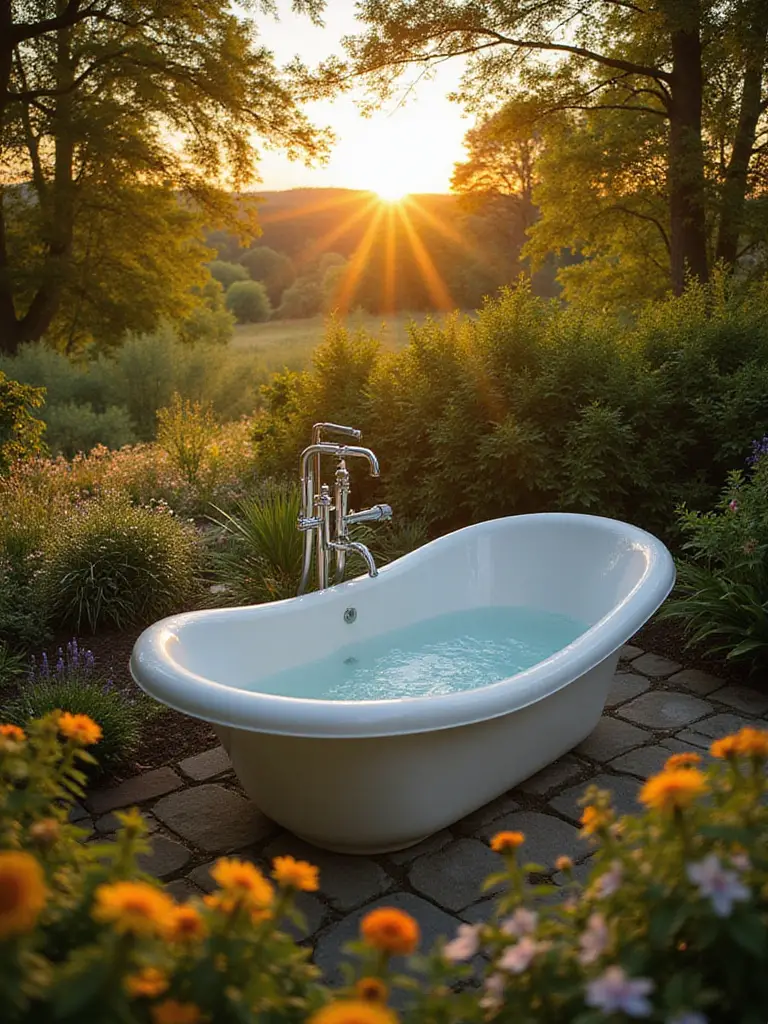
The site selection and preparation for outdoor tubs involves considerations of privacy, utilities access, drainage, and seasonal weather patterns. Foundation requirements typically exceed indoor installations due to freeze-thaw cycles and ground movement, while plumbing systems require freeze protection and proper insulation. The integration of heating systems extends usability into cooler seasons, making the investment practical in most climates.
Outdoor tub installation considerations:
- Privacy screening – Natural or constructed barriers for seclusion
- Utility access – Hot water supply and electrical service
- Weather protection – Covers and heating systems for year-round use
The design possibilities include integration with landscape features, outdoor lighting systems, and entertainment areas that create comprehensive outdoor living environments. The investment in outdoor bathing facilities often provides high returns in personal satisfaction and property value, particularly in markets where outdoor living is highly valued.
The unexpected environmental benefit includes opportunities for rainwater collection and greywater recycling systems that reduce environmental impact while creating sustainable outdoor bathing solutions.
23. Embrace Technology with Smart Bathtub Control Systems
Smart bathtub systems integrate home automation technology to provide precise control over water temperature, fill levels, and therapeutic features through smartphone apps or voice commands. The convenience of pre-filling tubs to exact specifications eliminates guesswork while ensuring optimal bathing conditions upon arrival. Advanced systems learn user preferences and can automatically adjust settings based on time of day, weather conditions, or individual user profiles.
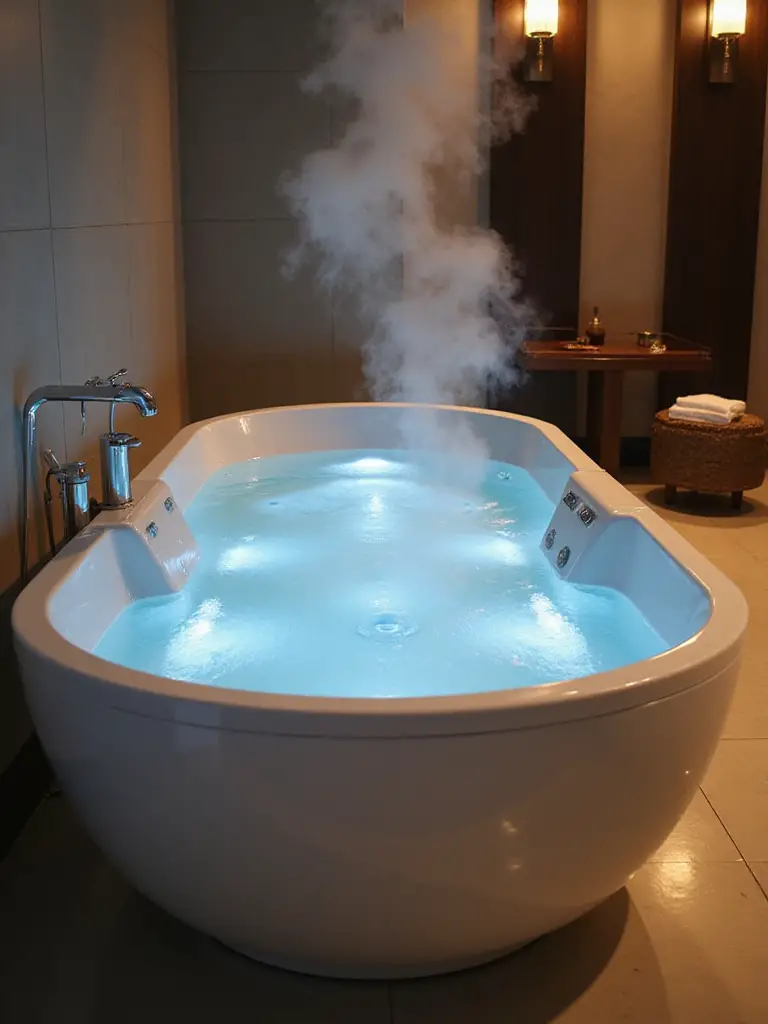
The technology integration includes Wi-Fi connectivity, smartphone apps, and compatibility with major home automation platforms like Alexa, Google Home, and Apple HomeKit. Safety features include automatic shut-off systems, temperature monitoring, and leak detection that provide peace of mind while enabling remote operation. The precision control possible with smart systems can reduce water waste while ensuring perfect bathing conditions every time.
Smart tub system capabilities:
- Remote operation – Fill and heat tubs before arriving home
- Precision control – Exact temperature and water level settings
- Safety monitoring – Automatic shut-off and leak detection systems
The integration possibilities extend to coordination with other bathroom systems, including lighting, ventilation, and audio systems that create comprehensive wellness environments controlled through single interfaces. The investment in smart technology provides convenience and efficiency while future-proofing bathroom installations for evolving home automation standards.
The forecast for smart bathroom technology suggests continued integration with health monitoring systems and artificial intelligence that will further personalize the bathing experience based on individual wellness needs and preferences.
24. Experience Vibroacoustic Therapy with Sound Bathtub Systems
Sound therapy bathtubs integrate vibroacoustic technology that transmits therapeutic frequencies directly through the body via water and tub structure, creating immersive wellness experiences that address both physical and psychological well-being. The technology transforms standard bathing into active therapy sessions that can reduce stress, alleviate pain, and promote deep relaxation through precisely calibrated sound waves and vibrations.
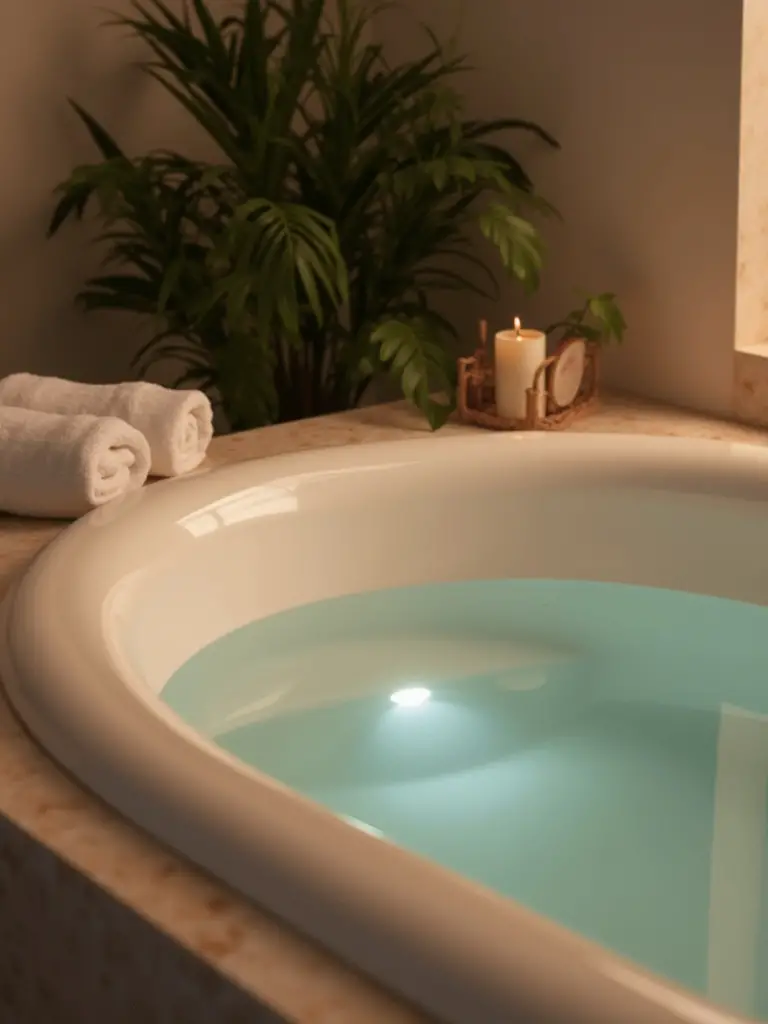
The science behind vibroacoustic therapy involves specific frequencies that resonate with body tissues, potentially reducing inflammation and promoting healing through mechanical stimulation. The integration of sound systems within bathtub structures ensures optimal transmission of therapeutic vibrations while maintaining the aesthetic integrity of the installation. Quality systems include extensive sound libraries with programs designed for specific therapeutic outcomes.
Vibroacoustic therapy applications:
- Stress reduction – Specific frequencies promote relaxation response
- Pain management – Vibrations can reduce muscle tension and inflammation
- Sleep improvement – Programs designed to promote restful sleep patterns
The installation requirements include specialized electrical systems and acoustic considerations that ensure optimal performance while maintaining safety standards. The investment in sound therapy technology represents the cutting edge of home wellness systems, providing access to therapeutic modalities previously available only in clinical settings.
The global wellness economy continues expanding into home environments, with sound therapy representing one of the most promising developments in residential wellness technology, offering measurable benefits for stress management and overall health improvement.
Transform Your Daily Ritual with the Perfect Bathtub Choice
The journey through these 24 bathtub ideas reveals the extraordinary potential within what many consider a simple fixture. From the sculptural presence of a freestanding tub that anchors an entire room to the therapeutic precision of smart systems that anticipate your needs, each option represents a different approach to the fundamental human need for cleansing, relaxation, and restoration. The diversity of materials—from the living patina of copper to the engineered perfection of stone resin—demonstrates how thoughtful selection can align your bathroom with your values, aesthetic preferences, and lifestyle requirements.
The evolution of bathtub design reflects broader changes in how we view our homes and personal wellness. Features like chromotherapy lighting, vibroacoustic therapy, and smart controls transform bathing from routine maintenance into active wellness practice. Safety innovations like walk-in designs and zero-threshold systems ensure that these benefits remain accessible throughout life’s changes, while space-saving solutions prove that even compact bathrooms can accommodate meaningful luxury.
Your ideal bathtub choice depends on the intersection of practical needs, aesthetic vision, and personal values. Whether you prioritize the timeless elegance of cast iron, the accessibility of walk-in designs, or the cutting-edge technology of smart systems, the perfect solution exists within this spectrum of possibilities. The investment in quality bathing facilities pays dividends in daily satisfaction, long-term home value, and the irreplaceable luxury of having a personal sanctuary where you can disconnect from the world’s demands and reconnect with yourself.
